
This is the second part of my survey of independent graphic designers working from all corners of the globe and it throws up some interesting results about how they charge. The first survey results concentrated on what designers do and how they make money.
Questions about charging are the most common I get in my inbox. Here’s how my trusty designer respondents answered…
Do you typically charge clients fixed-rate fees or hourly/daily rates?
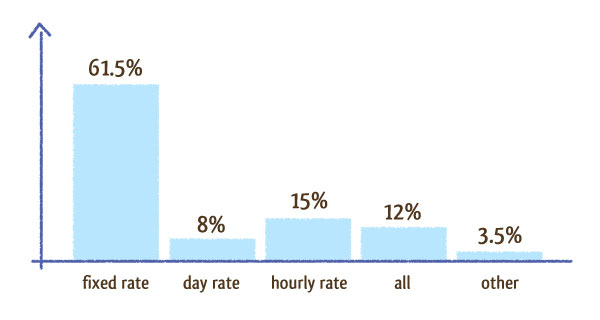
Clients and designers are most comfortable with fixed rate fees. Here, if both parties agree on the parameters of the task, the designer and the client know exactly how much it’s going to cost or pay before starting the project. Larger jobs are especially likely to be charged this way; whereas smaller jobs may be charged out at hourly rates.
Do you typically charge clients before or after project is completed?
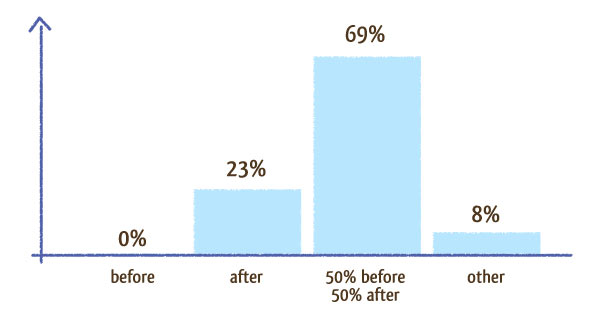
But when can the designers expect to get their grubby hands on the wonga? Half of it up front and the rest on completion is the most common arrangement, although many designers mentioned that this was only normal with new clients. When there is a good working relationship, a more lax attitude to payment can be adopted.
How quickly do you expect your clients to pay you after you invoice?
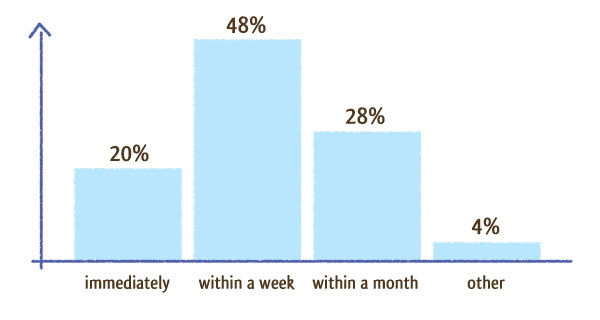
I was pleasantly surprised to see that many designers get paid straight away. Especially as the law in my country, the UK, permits 30 days to elapse between billing and receiving the money.
Do you bill manually or use billing software?
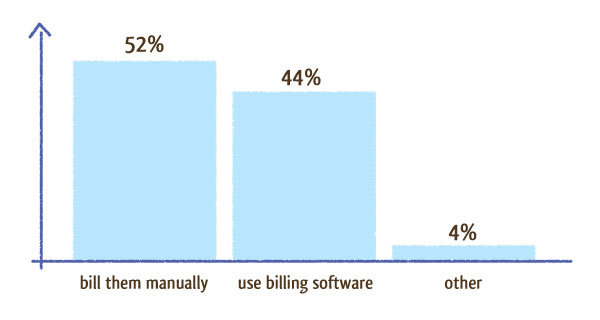
Nearly half of our designers use billing software. Here’s what they use:
- Harvest Set up takes seconds. Invoices created in minutes and in different currencies.
- Billings 3 for Mac combines powerful features with stylish designs so you can send elegant invoices right out of the box.
Further information about charging
Our designers gave these further points of clarification about their charging – some excellent advice here:
- “For publishing companies I usually get paid at the end of a project, within 15-30 days. For individual clients, typically self-publishers, I get 1/3 paid up-front, and the remaining 2/3 on completion of the project.”
- “I have an Access program that will create invoices as well as estimates.”
- “You can use PayPal to create invoices for you and you can also send W9’s electronically thanks to the good ol’ IRS.”
- “I charge per project on everything except for maintenance work. For that, I charge by the hour, with a minimum charge of 15 minutes. But for projects, the way I figure my fee is to calculate the number of hours and then add 50% for communication (emails, phone calls, NOT including face to face meetings. Because those can easily get long, I charge extra if I know a client will want any) and unforeseen problems that always crop up.”
- “If the client is a new client I usually ask for payment upfront (100% if it’s a small project or 50% upfront for bigger projects and the remaining 50% once completed). With my standard clients I invoice them monthly.”
- “New clients are fixed rate. Established clients are hourly.”
- “I tend to take a 20-30% deposit”
- “In regards to receiving payment after billing a client, it depends on the client. My biggest client takes literally weeks to pay, as all invoices are dealt with by people further up the chain, so-to-speak. However, for most work for regular clients, about 1-2 weeks appears to be the norm. I sometimes offer clients the change to pay in full before the project starts for a 5% discount. A fair few clients take this option, too.”
As ever, there are some interesting ideas there, especially the offer of a 5% discount in exchange for an upfront payment.
Do you have contracts with your clients?
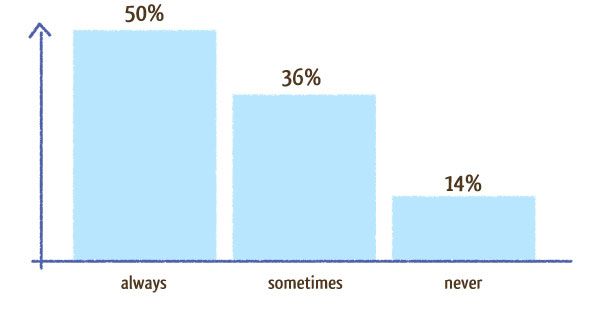
These were perhaps the most surprising results of the whole survey. I have often read that designers should always, always, always have contracts and it seems that this is not the case. I personally believe that 99% of people are honest and therefore it is much more important to be clear about the nature of the job and the payment than it is to sign contracts. However, some designers will disagree with me and, as you can see, 50% use contracts for every job.
Do you have written email exchanges where the price and extent of the job is discussed?
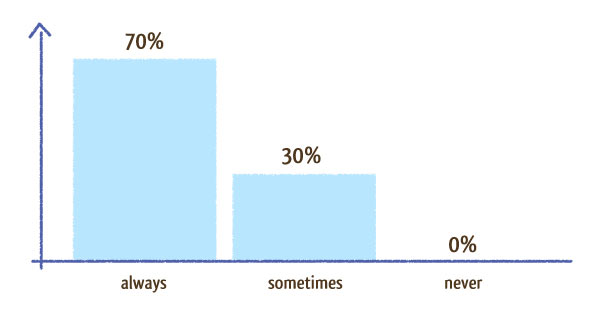
For me, leaving a “paper trail” of exchanges between you and the client can be even more important than a contract. Briefs can change during the course of a job so, in order that everyone understands the extent of the job and the payment, it’s advisable that conversations are recorded textually.
Do you discuss price and extent of the job with the client and leave it at that?
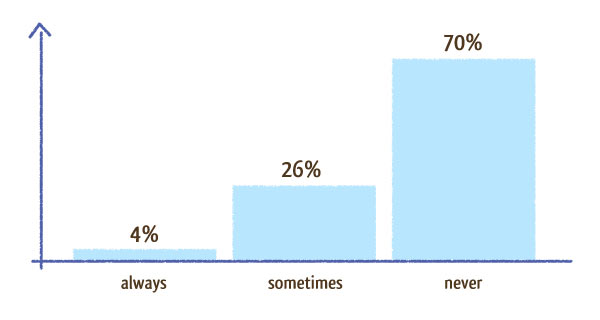
So, similarly, it’s not often that designers accept a brief on a phone without anything in writing. However, it’s possible that this can happen with a trusted client.
Further information on agreements and contracts
Here are some more helpful comments left by some designers about agreements and contracts:
- “I’ve only once had difficulty with – let’s call it – project creep. The project really got off the tracks and took far too long to complete. However, I was compensated fairly for the extra time; but it drove me crazy!”
- “I’ve never had a payment problem. I work a lot on referral these days. If I have a new client I always get the 50% up front (or if it’s a large project), but otherwise I’ll let that slide with someone I’ve worked with before.”
- “For new clients and larger projects I use a project agreement (contract just sounds so intimidating!) where I spell out the scope of the project, deliverables, timetable and payment schedule. I sign it and have the client sign it and return it with their deposit. Once I get to know a client well and we work on many projects together, I generally just use written agreements via email for small jobs and maintenance work. I always make sure to have something written in email that we’ve both agreed on, just in case I need to go back and reference it. I’ve been very fortunate to work with some great people and I’ve never had a problem with clients not paying (knock on wood!!).”
- “I used to have lots of clients but it became too much to manage, and some of them weren’t good with paying on time. I whittled my client base down to a select few clients which I’ve worked with for many years and have a good relationship with. Although I don’t have standard contracts with some of them, everything that is discussed is recorded in some fashion in chat logs or emails.”
- “Moderate to light detail contracts but lots of email trail. You don’t want to refer to contracts to resolve a problem when referring to a simple email does the trick and gets the project moving again. In the end you want to get paid, not go to court.”
- “I have learnt the hard way so from now on I will get every thing written down.”
- “Job specifications are recorded through email exchanges. I haven’t had payment problems for some time now because my work commences upon receipt of 50%, and the remaining 50% is received prior to supply of digital artwork.”
- “I have a contract attached to the quotation. They have to pay 50% up-front, and the rest when the project is finished. What causes payment problems? When the client doesn’t check his/her email after I have sent them the invoice!”
I tried to whittle those quotes down but they were all so interesting and echo the general success of the 50% before 50% after formula for payment.
Thank you
A huge thank you to everyone who participated. I learned a lot from this. So, heartfelt thanks to the following:
Lucas Tetrault from Phoenix Wave Portfolio
Lynne Venart from The Art Monkey
Matthew Harpin from Freelance Web & Logo Design
Michael King from Black Swan Image Works
Mike Smith from GUERRILLA
Randa Clay from Randa Clay WordPress Design
Ryan Scherf from Ryan Scherf
Stephen Tiano from Freelance book designer, page compositor & layout artist
Derek Kirk from creative web design
Andrew Keir from Melbourne graphic designer, Andrew Keir
Andrew Kelsall from Andrew Kelsall Design
Anne Swanson from Anne Swanson Graphic Design
Bob Raynor from Bob Raynor – Graphic Designer
Carmia Cronje from Clementine Creative
Chris Metzner from data visualization graphic designer
Craig Wilson from Craig Wilson
David Airey from David Airey, graphic designer
Douglas Bonneville from freelance graphic designer
Hernan Valencia from The Construct Creative
John O’Nolan from John O’Nolan
Jon Phillips from SpyreStudios
Justin Miller from Magnum Creative Group
Karen McDade from Omega Red
Kyle Richardson from Enrich Design
Lauren Krause from Creative Curio
Liam Swift from Attract Love to Your Brand
More to come
That’s not it! More questions about our designers’ equipment, software, and more great advice to come!
What do you think?
Are you a graphic designer who runs their own business or thinking of becoming a self-employed work-from-home type? What did you think of this survey? As always, I,d love to hear your thoughts. And, if you enjoyed the article, please consider tweeting or voting for it on your social network of choice!

Contracts are an interesting one. I think if you’re worried about your client sticking to an agreement, you’re taking on the wrong clients.
All my best clients have had no contract, worst ones have had one. Making a client sign a contract is often a silent admission that you know they’re going to be a pain in the ass, and/or not pay you.
🙂
Cheers, John. I’m with you on this one. I said in this post that I rarely bother with contracts and I got the holier-than-thou design fraternity up in arms about how remiss this was. I think trusting people can make them behave in a more trustworthy way. Also, I think there is more of a culture of having contacts in North America.
I am glad those of you that dont use contracts can work that way. I really wish I could, but it only takes one time not getting paid and that will change your mind. that one time was when I was young and was starting out on my own.
My contracts/agreements vary depending on the size and scop of the job. An contract for an annual report is going to be more complex than a client who needs soem business cards re printed.
I’m really surprised how quickly people are getting paid. I’ve found that with large companies, requiring anything less than a month (even six weeks) for an invoice to be paid is unreasonable. They simply have a lot of accounting to do, and your invoice is not necessarily on top of the pile. I’ve often been approached by other contractors (designers, developers, etc.) complaining that their client hasn’t paid them in less than 3 weeks, and they are already wondering if they should go to court, call and yell, etc. I tell them to be patient. These are businesses and they have lots going on, not just your invoice.
In response to Lynne, having been hired by a number of companies with staff levels greater than 1,000, I don’t think it’s unreasonable to expect payment within two weeks from invoicing. But you’re right about how there’s a difference in time frame. The larger the organisation, the higher the level of bureaucracy, and the more hoops involved in receiving payment.
Justin, I understand the “once bitten twice shy” argument. And now that you’ve got your contract routine off pat I bet they don’t take you any time to put in place. I love to see some of them. I wonder if there’s a good online collection of standard contracts?
Lynne, me too! I think this may be a pointer at how much work independent graphic designers are getting from independent entrepreneurs rather than from large organisations. In my experience, if a company of 1-3 people will pay up almost immediately. I should have asked a question about how big the clients are. Damn!
David, another bit of bureaucracy in large organisations is having correct codes on the invoices – make one mistake on an invoice and then you wait a month to get told to re-invoice and then another month to get paid. But, in my experience, big companies’ bureaucracy is worth putting up with and you will always get paid eventually!
And, thanks for the tweet, my server almost gave up as a result of it!
@Justin – You shouldn’t be so quick to assume that your experiences are more comprehensive or more relevant than those of others.
I have had non-paying clients. I have been screwed out of £15,000 by a single client before. Every client I’ve had that hasn’t paid me has had a contract. A completely useless contract. Know why? Because I, like most people (regardless of whether or not they realise it), can’t afford to take them to court.
An interesting read, and very useful to know how other designers handle the financial aspect of a project!
very insightful…
thanks!! 🙂
Hey Rob nice one for putting up so billing software links must check them out 🙂
I normally speak to the client and have a gentleman’s agreement but have learnt contracts can sure come in handy!
I’m with Lynne on this; a major client of mine always takes 4-6 weeks to pay, but have always paid me (about 30 invoices so far). Every company operates differently.
@JohnONolan > £15,000 0 Ouch! What kind of job was this?
Interesting results again, Rob 🙂
Wow, John, 15 grand unpaid does indeed sound like a sobering experience. The fact that you had a contract in place for that one makes me feel better about not having them but I know some people don’t feel comfortable without them.
Krishna, yes I find it interesting to find out what other designers do in every aspect of the business.
Derek, hope you’re well. The billing softwares were recommended by the designers in the survey. I hope you find the links useful.
Andrew, yes, I think they’re interesting. Thanks to you and everyone who took part. You awesome people! 😉
I’m with JohnONolan on this one…..1000%!
I’ve had the same experiences. One actually told me “take me to court and let’s see how deep your pocket are” (what he saying is he not going to pay you) are he project was completed.
On design projects for first time clients I now request a percentage retainer equal to what the conceptual cost phase of the project. If the potential client refuses to commit, I take this a ‘red flag’ he won’t pay the larger amount on completion and don’t waste anymore time on the proposal.
I find this works well for us. I set three phases for every project regarding the size of it: Conceptual, Design Development and Final Design. I use a standard template that I can revise in a quickly for each project which save us a lot of time.
This billing per phase works great for us.
Thanks for the post and allowing us to add our input.
TheKoolDots, interesting to hear about your separately billed phases. It’s often that last phase when the site is 90% coded and the client asks for design changes where problems can occur. And, you’re definitely right about the ‘red flag’ when potential clients refuse to commit. I always think ‘good riddance!’ Cheers!
This is very extensive. I work very similarly to what you’ve found. Especially when it comes to billing before and after. Designers today simple shouldn’t conduct business by trusting the client will come through in the end. Contracts are a must. I’ve retweeted your stats. Thanks.
Thanks for the RT, Dennis, and you comments on getting paid before the project. Sorry I didn’t reply sooner, btw!
Very interesting to read. We have been using a few graphic designers and are constantly doing that. To know how they get paid from other companies helps us in planning our future as well.
Hey Matt, glad you found this helpful – coming from the “other side of the fence” as well 🙂
I have to say this is a very illuminating article. I think the idea of offering a small discount for paying upfront is genius, I’ll have to try that. As for contracts I agree, using contracts seems like overkill and might even scare off the odd client. I like to sort of slip a small agreement section in with the quote. Something that states the payment arrangement and the extent of service to be provided. After that I have them sign it and return it within 30 days with the deposit.
Hello Shane, good to see you here as well as on Twitter!
It’s a great idea for a discount incentive for an upfront payment. Stating the payment arrangement and the extent of service to be provided is absolutely something you should do. 🙂
hey rob, nice analysis . You have great knowledge of graphic designer strategy.
It is the beneficial for designers to get payment for clients.
Thanks Graham.
In regards to contract signing, I find Echosign to be indispensable.! Many of my clients are not local and so I can’t stress enough how much time and effort that saves me! As well as securing a project that perhaps I may not have gotten had I needed to meet in person for signatures and sending contracts!
Really good point, Alisha, I’ve never used Echosign but I can totally see how useful it could be for peace of mind and security while working for clients overseas.
Great blog.
Thank you, Santa
Hello!
I would like to work in graphic design but I don’t have experience..
I don’t know how to start…
I need someone in the sector who can give me an advise. I’m from Barcelona and I’m living in London, I would like to stay here what do you think is the best option if I would like to work in graphic design in the future? do you think the courses online worth it?
Thank you very much 🙂
Charlotte
Yes, it is possible to become a web designer. There is enough information online to be able to find out how to do it. It doesn’t really matter where you are in the world.
I have an article here that is about teaching yourself web design.
Most of my clients are small to start up businesses. I have been having A LOT of issues lately with them not paying within 30 – 60 days. I’m usually very linant and allow them to make up to three payments considering they are start ups but I’m still getting burned. I even have one that after I completed the work decided he didn’t want to go that route. He currently owes me $3500. I have signed contracts but these new clients, I”m tempted to say “All payment up front”. Anyone have any advice?
I’m really sorry to hear of your problems, Marcia. It’s happened to me, unfortunately. Small businesses and startups can be like this. Well done for having contracts. Have you seen this article I wrote more recently called How To Deal With Nightmare Clients? I explain in more detail how to avoid these situations in the first place. Identify the clients you don’t want to work for first!
Also in the above articles are details of how, if you are UK-based, you can do small money claims online which puts the late-paying client into a system that could result in them going to court – and only for £60! If you’re not UK-based sometimes an official letter from a solicitors can go a long way. Phone calls and personal calls are better than emails.
I’ve personally never asked for all money up front. It’s an idea though.
That’s a good article. Thanks Rob.
Thanks, Marcia.
I know this is unpopular, but I charge in-full, up-front for all my design work. My target clients are Stay At Home Moms looking to start online businesses. When I first started out, I did the 50/50 setup.
About half my clients (which SHOCKED me!) would email me with sob stories about financial hardship, stating that they could not pay the remaining balance when the work was completed.
After that, I learned my lesson! I’m a pretty highly sought-after designer as far as Mommy Bloggers go, and I have an excellent track record of meeting deadlines, providing quality work, etc. My past clients happily vouch for me. I feel that my reputation justifies charging up front!
You’re not unpopular with me, Jessica. If that’s what works for you, go for it! I’m absolutely shocked by your treatment so far. Really terrible that they are giving you sob stories when we all have problems. And you’re getting this from 50%? That is a terrible statistic! I have to say that the worst people to work for in terms of payments, sometimes, would be stay at home self-starting bloggers – because their budgets will always be very low. The best clients for paying, unfortunately, are large organisations.
Off topic, you may be interested in this interview with Randa Clay, a Mommy Blogger WordPress themer, who’s done very well setting up a WP theme shop.